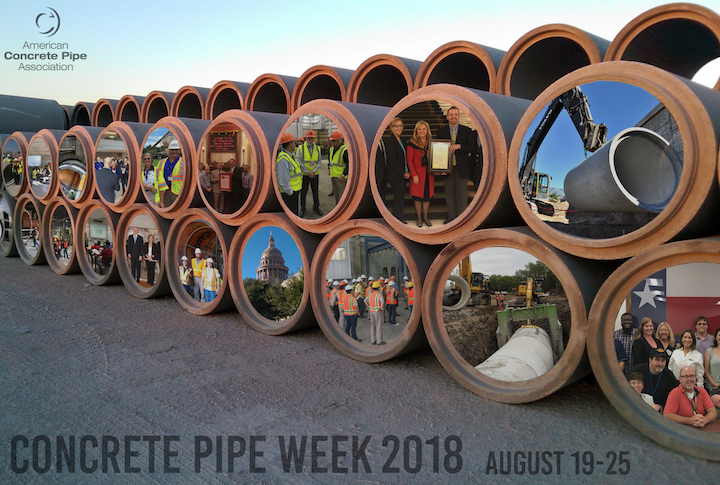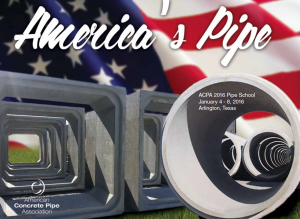Russell Tripp, President American Concrete Pipe Association
As we round out 2018 and look to identify trends for 2019, one constant is the strength of the reinforced concrete pipe market. While federal funding is flat, many states are successfully passing increased gas taxes and/or user fees. Furthermore, there are substantial rumors that federal funding on infrastructure could be back on Congress’ agenda, though getting consensus will likely take some time. However, many are optimistic. The Portland Cement Association stated in their fall report that the economy is strong and cement consumption will grow 2.9% by year-end. The pace of construction activity is expected to remain strong at 2.6% in 2019.
For the American Concrete Pipe Association (ACPA), our key focus will be to help producer members meet market demand, building on their long-term proven engineered products. This involves ACPA’s continual efforts to fight legislation, codes and standards that limit engineers’ ability to choose the right pipe solution for their project. Legislation has been introduced recently in both the House and Senate that would, if enacted, significantly alter the role of engineers in the procurement of construction materials for taxpayer-funded infrastructure projects. Known in the House as the Municipal Infrastructure Savings and Transportation Act and in the Senate as the Water Infrastructure Transparency Act, these measures would legislatively force project engineers to accept pipe materials that may not be suited for the project. What’s more, such legislation would challenge the ability of engineers, utilities, local governments, and other public works professionals to design infrastructure projects in the manner that best serves the needs of their communities. Longevity of concrete pipe is proven, and ACPA recognizes the importance of an engineer’s role in materials selection.
This sentiment was validated this summer when ACPA interviewed industry stakeholders representing consulting engineers, contractors, public agencies and more. When asked about the single most important benefit of reinforced concrete pipe, 40% noted longevity and durability and 20% highlighted that it is a structurally-superior and forgiving product. Other key responses included life-cycle cost, availability, ease of installation and familiarity of the product.
According to Randy Wahlen, PE, Marketing Engineer for Oldcastle Infrastructure and Chair of ACPA’s Marketing Task Group conducting the market research, the majority of those interviewed touted that reinforced concrete pipe is the answer. So, why isn’t it always selected?
“Since reinforced concrete pipe has been a solution for more than 175 years in the USA, and the Romans and civilizations before used concrete drainage systems and aqueducts, we take for granted that longevity and durability are a given,” said Wahlen. “However, one of the things our industry needs to do a better job of is reminding specifiers and standards writers that concrete pipe is a not just proven, but also a highly engineered product.”
As infiltration and exfiltration standards have changed considerably over the last century, so has the performance of concrete pipe and concrete pipe joints. Concrete pipe offers the design engineer several different joint types, depending on the application, to meet the utmost demanding project specifications. Because of its superior durability, strength and joint system performance, concrete pipe remains the pipe of choice for many engineers and owners of drainage and sanitary sewer projects. In addition, concrete pipe is gaining favor as the choice for constructing resilient infrastructure designed to resist natural disasters – ranging from floods to fires. Fires in the vicinity of concrete pipeline systems generally don’t affect structural strength or flow capacity; the two fundamental requirements of a gravity pipeline drainage or collection system.
Finally, one trend we wish was changing as we move into 2019 is the continual workforce shortage. Approximately 60% of those interviewed in the ACPA survey noted that their biggest challenge was and continues to be finding qualified workers. It’s no secret the skilled worker shortage is at an all-time high. Many construction workers left the industry during the 2008 recession due to challenges in finding work. Seasoned workers who remained will soon retire, and new entrants to the workforce are passing over construction for high-tech careers.
“With the construction industry’s labor shortage showing no sign of abating, innovative solutions such as precast concrete are addressing the need,” said Wahlen. “Precast concrete offers unparalleled quality, strength and longevity when compared to other products. The concrete pipe industry can help meet this worker shortage in the United States.”
Concrete pipe plants and the quality of concrete pipe and precast products are the core interest of the ACPA. Concrete pipe producers welcome visits by Departments of Transportation, public works engineers, specifiers, regulators, and elected representatives. If you haven’t yet taken the tour – now is the time to witness a standard modern product being produced in 21st century plants!
Comment below, we’d love to hear your thoughts! Have you taken a plant tour?






Great article. Precast concrete products will be an essential part of meeting future construction demands.